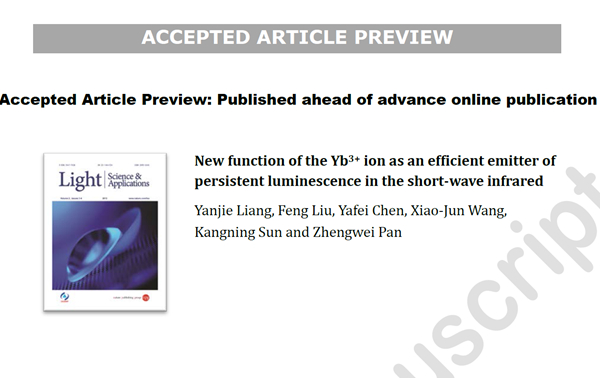
Recently, researchers from the Key Laboratory for Liquid-Solid Structure Evolution and Processing of Materials, Shandong University and University of Georgia have made an important progress in short-wave infrared persistent luminescence materials. The research paper entitled “New function of the Yb3+ as an efficient emitter of persistent luminescence in the short-wave infrared” was published in Nature Publishing Group Journal–Light: Science & Applications (DOI: 10.1038/lsa.2016.124, IF=14.602) on March 3, 2016. Yanjie Liang, the PhD candidate from Shandong University, is the first author of this research paper. Prof. Kangning Sun in Shandong University and Prof. Zhengwei Pan in the University of Georgia are the co-corresponding authors of this paper.
Trivalent ytterbium (Yb3+) has the simplest 4f energy-level structure among the rare-earth ions, but it possesses several unique, fascinating optical properties such as strong absorption and intense emission at ~1000 nm which is in the short-wave infrared (SWIR; 950–1700 nm) range. Because of its novel optical properties, Yb3+ ion has been extensively investigated and used over the past two decades in a variety of important applications; for instances, as the emitter in diode-pumped solid-state SWIR lasers, as the sensitizer (by absorbing 980 nm photons) to activate other lanthanide ions (e.g., Er3+ ion) for up-conversion luminescence, and as the spectral converter in Ln3+-Yb3+ doubly doped quantum cutting phosphors for Si photovoltaics. Recently, the researchers from Shandong University and University of Georgia report on a new function of Yb3+ ion–as an excellent emitting center for SWIR persistent luminescence. They have developed the first real SWIR persistent phosphor, Yb3+-doped MgGeO3, which exhibits a very-long SWIR persistent luminescence of >100 h after ultraviolet (UV) light excitation.
The new function of Yb3+ ion as an SWIR persistent luminescence emitting center represents a breakthrough in Yb3+ research and applications. The achievement of long SWIR persistent luminescence in MgGeO3:Yb3+ and other Yb3+-activated phosphors would impact not only the fields of luminescence physics and luminescent materials, but also many other technologically important fields such as biomedical imaging, night-vision surveillance and Si photovoltaics.
The research projects in Prof. Kangning Sun’s group are focused on bio-ceramic materials and optical probes for bio-imaging, Prof. Zhengwei Pan’s group in University of Georgia has been very active in the research and development of novel near infrared persistent luminescence materials. The two research groups began the collaborative research by co-educating graduate students since 2012. By combining the advantages of both sides, the international horizon of graduate students from Shandong University is broadened, and the scientific research ability and the creative thinking ability are also improved. Other collaborative research works of Yanjie Liang in the University of Georgia have also been successively published in the well-known physics and chemistry journals, includingPhysical Review Letters,Dalton Transactions,Advanced Optical Materials, etc.
Prof. Zhengwei Pan acknowledges financial support from the National Science Foundation (CAREER DMR-0955908, DMR-1403929). Prof. Kangning Sun is grateful for the financial support from the National Natural Science Foundation of China (No. 81171463). Yanjie Liang acknowledges support from the China Scholarship Council (201206220027).
The link of the research paper:
http://www.nature-lsa.cn:8080/cms/accessory/files/AAP-lsa2016124.pdf
Translated by: Sun Xiaoning, Zhang Jingde
Edited by: Zhou Chuanjian
Source: School of Material Science and Engineering